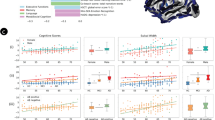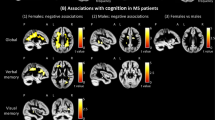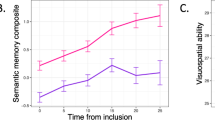Abstract
The SORL1 rs2070045 polymorphism was reported to be associated with SorLA expression in the brain and the risk of late-onset Alzheimer’s disease (AD). However, the influence of this polymorphism on cognitive functioning is likely to be moderated by sex. This study aimed to examine the sex moderation on the effects of rs2070045 on neuropsychological performance and the cingulum integrity in Chinese Han population. In this study, 780 non-demented older adults completed a battery of neuropsychological scales. Diffusion tensor images (DTI) of 126 subjects were acquired. We adopted the atlas-based segmentation strategy for calculating the DTI indices of the bilateral cingulum and cingulum hippocampal part for each subject. We used a multivariate analysis of variance (MANOVA) to compare the cognitive performance and DTI differences between the rs2070045 genotype. Controlling for age, education, and the APOE ɛ4 status, the influence of sex on the effects of the rs2070045 polymorphism on executive function was observed. We also found an interaction between sex and the rs2070045 polymorphism on the white matter (WM) microstructure of the left cingulum hippocampal part. Furthermore, the mean diffusivity and axial diffusivity of the tract were associated with Trail Making Test performance in T/T men. These results hint that sex moderates the association between the rs2070045 polymorphism and executive function, as well as the WM integrity of the left cingulum hippocampal part. Our findings underscore the importance of considering the influence of sex when examining the candidate genes for cognitive abilities and AD.
Similar content being viewed by others
Log in or create a free account to read this content
Gain free access to this article, as well as selected content from this journal and more on nature.com
or
References
Bertram L, McQueen MB, Mullin K, Blacker D, Tanzi RE (2007). Systematic meta-analyses of Alzheimer disease genetic association studies: the AlzGene database. Nat Genet 39: 17–23.
Bretsky P, Guralnik JM, Launer L, Albert M, Seeman TE, MacArthur Studies of Successful A (2003). The role of APOE-epsilon4 in longitudinal cognitive decline: MacArthur Studies of Successful Aging. Neurology 60: 1077–1081.
Caglayan S, Bauerfeind A, Schmidt V, Carlo AS, Prabakaran T, Hubner N et al (2012). Identification of Alzheimer disease risk genotype that predicts efficiency of SORL1 expression in the brain. Arch Neurol 69: 373–379.
Cahill L (2006). Why sex matters for neuroscience. Nat Rev Neurosci 7: 477–484.
Catheline G, Periot O, Amirault M, Braun M, Dartigues JF, Auriacombe S et al (2010). Distinctive alterations of the cingulum bundle during aging and Alzheimer's disease. Neurobiol Aging 31: 1582–1592.
Cellini E, Tedde A, Bagnoli S, Pradella S, Piacentini S, Sorbi S et al (2009). Implication of sex and SORL1 variants in italian patients with Alzheimer disease. Arch Neurol 66: 1260–1266.
Corder EH, Saunders AM, Strittmatter WJ, Schmechel DE, Gaskell PC, Small GW et al (1993). Gene dose of apolipoprotein E type 4 allele and the risk of Alzheimer's disease in late onset families. Science 261: 921–923.
Douaud G, Jbabdi S, Behrens TE, Menke RA, Gass A, Monsch AU et al (2011). DTI measures in crossing-fibre areas: Increased diffusion anisotropy reveals early white matter alteration in MCI and mild Alzheimer's disease. NeuroImage 55: 880–890.
Felsky D, Szeszko P, Yu L, Honer WG, De Jager PL, Schneider JA et al (2013). The SORL1 gene and convergent neural risk for Alzheimer's disease across the human lifespan. Mol Psychiatr 19: 1125–1132.
Gosso MF, de Geus EJ, Polderman TJ, Boomsma DI, Heutink P, Posthuma D (2008). Catechol O-methyl transferase and dopamine D2 receptor gene polymorphisms: evidence of positive heterosis and gene-gene interaction on working memory functioning. Eur J Hum Genet 16: 1075–1082.
Guo Q, Zhao Q, Chen M, Ding D, Hong Z (2009). A comparison study of mild cognitive impairment with 3 memory tests among Chinese individuals. Alzheimer Dis Assoc Disord 23: 253–259.
Guo QH, Hong Z, Lv CZ, Zhou Y, Lu JC, Ding D (2005). Application of Stroop color-word test on Chinese elderly patients with mild cognitive impairment and mild Alzheimer's dementia. Chinese J Neuromed 4: 701–704.
Guo QH, Hong Z, Shi WX, Sun YM, Lv CZ (2006). Boston naming test using by Chinese elderly, patient with mild cognitive impairment and Alzheimer's dementia. Chinese Mental Health J 20: 81–85.
Heise V, Filippini N, Ebmeier KP, Mackay CE (2011). The APOE varepsilon4 allele modulates brain white matter integrity in healthy adults. Mol Psychiatr 16: 908–916.
Houlihan LM, Harris SE, Luciano M, Gow AJ, Starr JM, Visscher PM et al (2009). Replication study of candidate genes for cognitive abilities: the Lothian Birth Cohort 1936. Genes Brain Behavior 8: 238–247.
Ishiai S, Sugishita M, Ichikawa T, Gono S, Watabiki S (1993). Clock-drawing test and unilateral spatial neglect. Neurology 43: 106–110.
Kantarci K, Senjem ML, Avula R, Zhang B, Samikoglu AR, Weigand SD et al (2011). Diffusion tensor imaging and cognitive function in older adults with no dementia. Neurology 77: 26–34.
Kolsch H, Jessen F, Wiltfang J, Lewczuk P, Dichgans M, Teipel SJ et al (2009). Association of SORL1 gene variants with Alzheimer's disease. Brain Res 1264: 1–6.
Lee JH, Barral S, Reitz C (2008). The neuronal sortilin-related receptor gene SORL1 and late-onset Alzheimer's disease. Curr Neurol Neurosci Rep 8: 384–391.
Lee JH, Cheng R, Schupf N, Manly J, Lantigua R, Stern Y et al (2007). The association between genetic variants in SORL1 and Alzheimer disease in an urban, multiethnic, community-based cohort. Arch Neurol 64: 501–506.
Liang WS, Dunckley T, Beach TG, Grover A, Mastroeni D, Ramsey K et al (2008). Altered neuronal gene expression in brain regions differentially affected by Alzheimer's disease: a reference data set. Physiol Genomics 33: 240–256.
Liu F, Ikram MA, Janssens AC, Schuur M, de Koning I, Isaacs A et al (2009). A study of the SORL1 gene in Alzheimer's disease and cognitive function. J Alzheimer's Dis 18: 51–64.
Lu JC, GQ C, Hong Z, Shi WX, Lv CZ (2006). Trail making test used by Chinese elderly patients with mild cognitive impairment and mild Alzheimer dementia. Chinese J Clin Psychol 4: 118–121.
Meng Y, Lee JH, Cheng R St, George-Hyslop P, Mayeux R, Farrer LA (2007). Association between SORL1 and Alzheimer's disease in a genome-wide study. Neuroreport 18: 1761–1764.
Meyer-Lindenberg A, Weinberger DR (2006). Intermediate phenotypes and genetic mechanisms of psychiatric disorders. Nat Rev Neurosci 7: 818–827.
Mok EH, Lam LC, Chiu HF (2004). Category verbal fluency test performance in chinese elderly with Alzheimer's disease. Dement Geriatr Cogn Disord 18: 120–124.
Nestor PG, Kubicki M, Spencer KM, Niznikiewicz M, McCarley RW, Shenton ME (2007). Attentional networks and cingulum bundle in chronic schizophrenia. Schizophrenia Res 90: 308–315.
Ning M, Yang Y, Zhang Z, Chen Z, Zhao T, Zhang D et al (2010). Amyloid-beta-related genes SORL1 and ACE are genetically associated with risk for late-onset Alzheimer disease in the Chinese population. Alzheimer Dis Associated Disord 24: 390–396.
O'Sullivan M, Barrick TR, Morris RG, Clark CA, Markus HS (2005). Damage within a network of white matter regions underlies executive dysfunction in CADASIL. Neurology 65: 1584–1590.
Offe K, Dodson SE, Shoemaker JT, Fritz JJ, Gearing M, Levey AI et al (2006). The lipoprotein receptor LR11 regulates amyloid beta production and amyloid precursor protein traffic in endosomal compartments. J Neurosci 26: 1596–1603.
Reitz C, Cheng R, Rogaeva E, Lee JH, Tokuhiro S, Zou F et al (2011). Meta-analysis of the association between variants in SORL1 and Alzheimer disease. Arch Neurol 68: 99–106.
Reynolds CA, Zavala C, Gatz M, Vie L, Johansson B, Malmberg B et al (2013). Sortilin receptor 1 predicts longitudinal cognitive change. Neurobiol Aging 34: 1710 e1711–1710 e1718.
Rogaeva E, Meng Y, Lee JH, Gu Y, Kawarai T, Zou F et al (2007). The neuronal sortilin-related receptor SORL1 is genetically associated with Alzheimer disease. Nat Genet 39: 168–177.
Schermuly I, Fellgiebel A, Wagner S, Yakushev I, Stoeter P, Schmitt R et al (2010). Association between cingulum bundle structure and cognitive performance: an observational study in major depression. Eur Psychiatr 25: 355–360.
Seshadri S, DeStefano AL, Au R, Massaro JM, Beiser AS, Kelly-Hayes M et al (2007). Genetic correlates of brain aging on MRI and cognitive test measures: a genome-wide association and linkage analysis in the Framingham Study. BMC Med Genet 8: S15.
Sheridan LK, Fitzgerald HE, Adams KM, Nigg JT, Martel MM, Puttler LI et al (2006). Normative Symbol Digit Modalities Test performance in a community-based sample. Arch Clin Neuropsychol 21: 23–28.
Shulman JM, Chibnik LB, Aubin C, Schneider JA, Bennett DA, De Jager PL (2010). Intermediate phenotypes identify divergent pathways to Alzheimer's disease. PloS one 5: e11244.
Small BJ, Rosnick CB, Fratiglioni L, Backman L (2004). Apolipoprotein E and cognitive performance: a meta-analysis. Psychol Aging 19: 592–600.
Tan EK, Lee J, Chen CP, Teo YY, Zhao Y, Lee WL (2009). SORL1 haplotypes modulate risk of Alzheimer's disease in Chinese. Neurobiol Aging 30: 1048–1051.
Tanzi RE, Bertram L (2005). Twenty years of the Alzheimer's disease amyloid hypothesis: a genetic perspective. Cell 120: 545–555.
Tsai SJ, Hong CJ, Yeh HL, Liou YJ, Yang AC, Liu ME et al (2011). Heterozygote advantage of the MTHFR C677T polymorphism on specific cognitive performance in elderly Chinese males without dementia. Dement Geriatr Cogn Disord 32: 159–163.
Wheeler-Kingshott CA, Cercignani M (2009). About ‘axial’ and ‘radial’ diffusivities. Magnet Reson Med 61: 1255–1260.
Xie S, Xiao JX, Wang YH, Wu HK, Gong GL, Jiang XX (2005). Evaluation of bilateral cingulum with tractography in patients with Alzheimer's disease. Neuroreport 16: 1275–1278.
Xue X, Zhang M, Lin Y, Xu E, Jia J (2014). Association between the SORL1 rs2070045 polymorphism and late-onset Alzheimer's disease: interaction with the ApoE genotype in the Chinese Han population. Neurosci Lett 559: 94–98.
Yoon B, Shim YS, Lee KS, Shon YM, Yang DW (2008). Region-specific changes of cerebral white matter during normal aging: a diffusion-tensor analysis. Archi Gerontol Geriatr 47: 129–138.
Zeeberg B (2002). Shannon information theoretic computation of synonymous codon usage biases in coding regions of human and mouse genomes. Genome Res 12: 944–955.
Zhang MY, Katzman R, Salmon D, Jin H, Cai GJ, Wang ZY et al (1990). The prevalence of dementia and Alzheimer's disease in Shanghai, China: impact of age, gender, and education. Ann Neurol 27: 428–437.
Zhou Y, Lu JC, Guo QH, Hong Z (2006). Rey-Osterriche complex figure test used to identify mild Alzheimer's disease. Chin J Clin Neurosci 14: 501–504.
Author information
Authors and Affiliations
Corresponding author
Additional information
Author Contributions
Z.J.Z. had full access to all of the data in the study and takes responsibility for the integrity of the data and the accuracy of the data analysis. Z.J.Z. conceived the original idea for the study and supervised in the conception. Y.L., H.L., C.L.L., X.L., and J.Y.Z. recruited the study population and conducted the neuropsychological tests. Y.L., H.L., and C.L.L. analyzed the data. Y.L., H.L., and C.L.L. drafted the manuscript. N.S., K.W.C. and L.P.H revised the manuscript. All authors read and approved the final manuscript.
Supplementary Information accompanies the paper on the Neuropsychopharmacology website
Supplementary information
PowerPoint slides
Rights and permissions
About this article
Cite this article
Liang, Y., Li, H., Lv, C. et al. Sex Moderates the Effects of the Sorl1 Gene rs2070045 Polymorphism on Cognitive Impairment and Disruption of the Cingulum Integrity in Healthy Elderly. Neuropsychopharmacol 40, 1519–1527 (2015). https://doi.org/10.1038/npp.2015.1
Received:
Revised:
Accepted:
Published:
Issue date:
DOI: https://doi.org/10.1038/npp.2015.1
This article is cited by
-
Modulation effect of the SORL1 gene on functional connectivity density in healthy young adults
Brain Structure and Function (2016)



